
Rams and Bengals: A Uniform History
Super Bowl LVI
The Los Angeles Rams and Cincinnati Bengals face off in the eagerly anticipated Super Bowl LVI at Sofi Stadium this Sunday, February 13th! Both teams have donned iconic logos and uniforms throughout the histories of their franchises. From the trademark tiger stripes on the Bengals jerseys, to the historic golden horns on the Rams helmets, follow the stories of each Super Bowl team’s uniform over the decades.
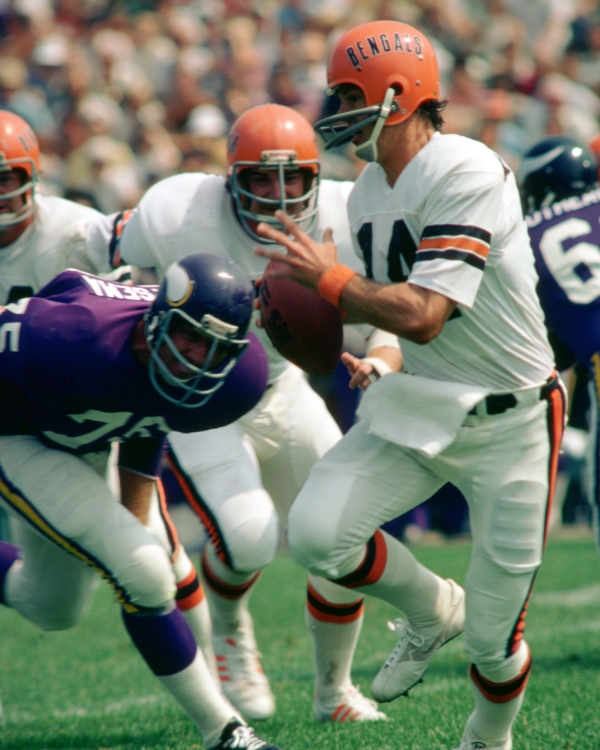
The Bengals' Beginning
When the Cincinnati Bengals franchise made its debut in 1968, their uniforms took significant inspiration from the Cleveland Browns. Designed with orange, black and white team colors, the uniform had not yet featured any stripes. Another glaring difference in detail was the lack of “TV numbers” on their jersey sleeves. Until 1980, they were the only team in the NFL without secondary uniform numbers.
The Bengals Flash Their Stripes
In 1981, the Bengals would abandon their Cleveland-like uniforms and unveil the black tiger stripes that made their jerseys, pants and helmets so unique. Guard Glenn Bujnoch and linebacker Reggie Williams would be the first to model the new uniforms.
General Manager Paul Brown explained, “The league has been after us for some while to get more distinctive uniforms. Now, when people see us on TV, they’ll know it’s our team.”
An artist was enlisted to ensure the new uniforms caught the eyes of the audience both up close, and from afar. The jerseys had shoulder stripes, the pants featured a four-inch wide side panel with black and orange tiger stripes, and the helmets had wavy stripes inspired by a Bengal tiger’s head. These helmets are still worn to this day.
Brown concluded, “When the Rams came out with their helmets and those horns on them, everybody rolled off their chairs laughing. But now, they’ve probably got the most distinctive helmets in the league, and the other teams would like to have the same thing.”
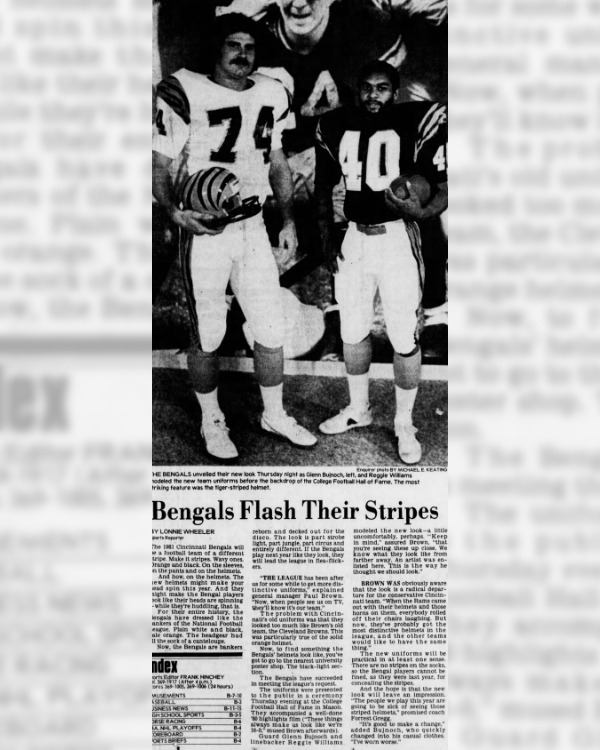
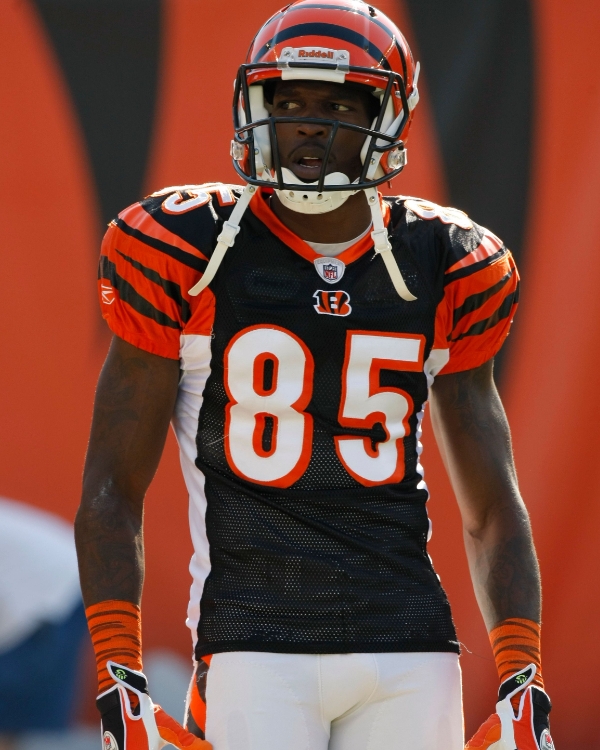
The Bengals would incorporate new logos and design changes through the years, but the trademarked stripes would remain. In 1997 a logo of a leaping tiger was added to the jersey sleeves, and in 2004, the tiger stripe pattern was updated. Also that year, the team’s signature, orange “B” logo was introduced with black tiger stripes. Alternate jerseys and white uniforms to combat the heat would also make appearances on players like Chad “Ochocinco” in the years to come.
The Rams' Roots
The Rams franchise began in Cleveland, Ohio in 1936, when the team’s colors were red and dark blue. From red helmets, shoulders and sleeves to blue uniforms and tan pants, the team’s look was unrecognizable compared to what it is today.
However, one year later, the team would change their colors to royal blue and gold. These new uniforms would undergo another design alteration in the mid 1940s, as royal blue uniforms with gold numbers became gold uniforms with navy blue serif numerals. This would be the team’s look as they moved to Los Angeles in 1946.
In 1948, the LA Rams became the first team to feature an emblem on their helmets, when halfback and technical designer, Fred Gehrke painted horns on his helmet. Rams owner Dan Reeves received approval from the NFL, the crowd went wild, and the rest is history. Gehrke’s helmet design is still worn today.
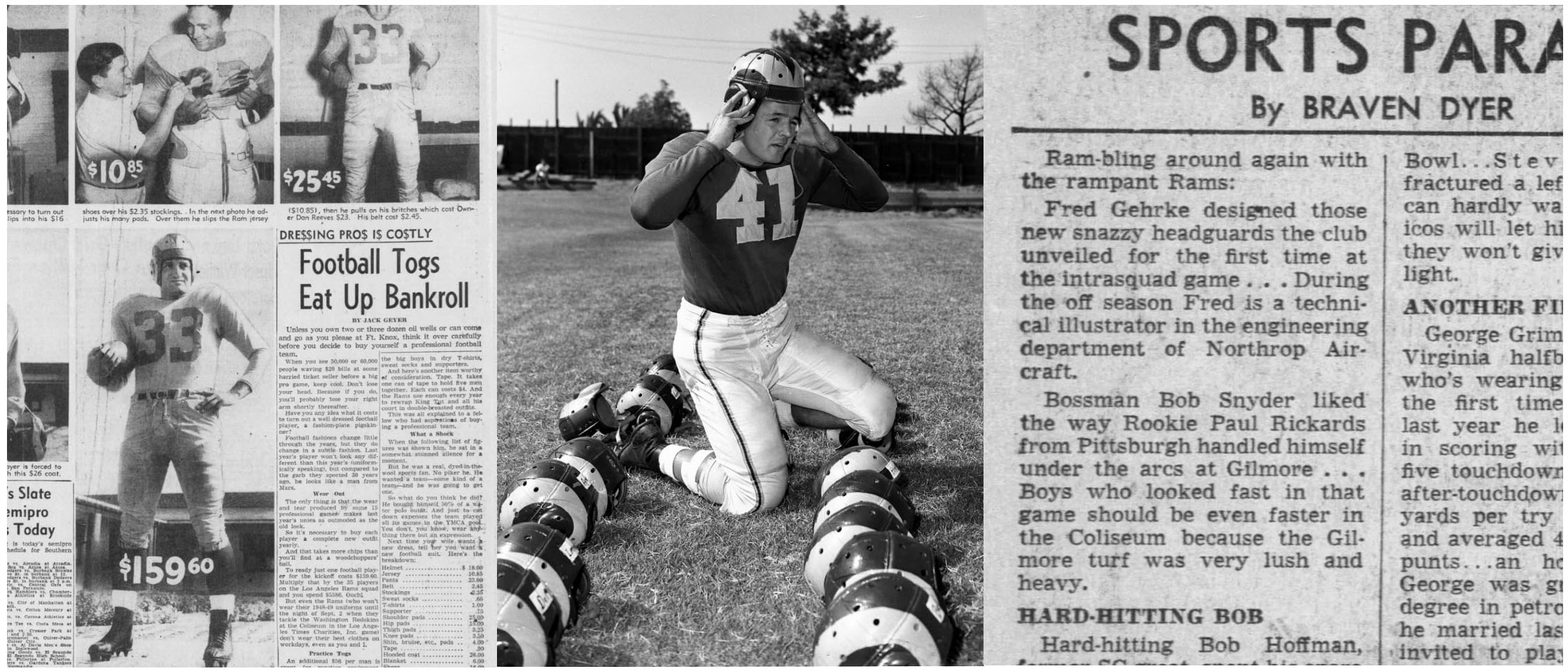
The next year, the team would change up their team colors yet again, eliminating blue and incorporating red. This color scheme only lasted one year, as the Rams returned to their blue and yellow theme in 1949, and stuck with it for the following 14 seasons.
The Rams would abandon the color yellow from their uniforms from 1964-73, wearing primarily white jerseys with blue accents for most of their games. Occasionally on the road, the team would suit up in blue jerseys throughout this time period, but this was rare.
The Rams' Get a Total New Look
Rams’ President Carroll Rosenbloom took ownership of the team in 1972. He called for a “total new look” for the team the following year. Yellow would return to all parts of the team’s uniform, complemented by newly designed yellow horns on the shoulders and sleeves. This became the iconic look for the rest of the Rams’ time in LA.
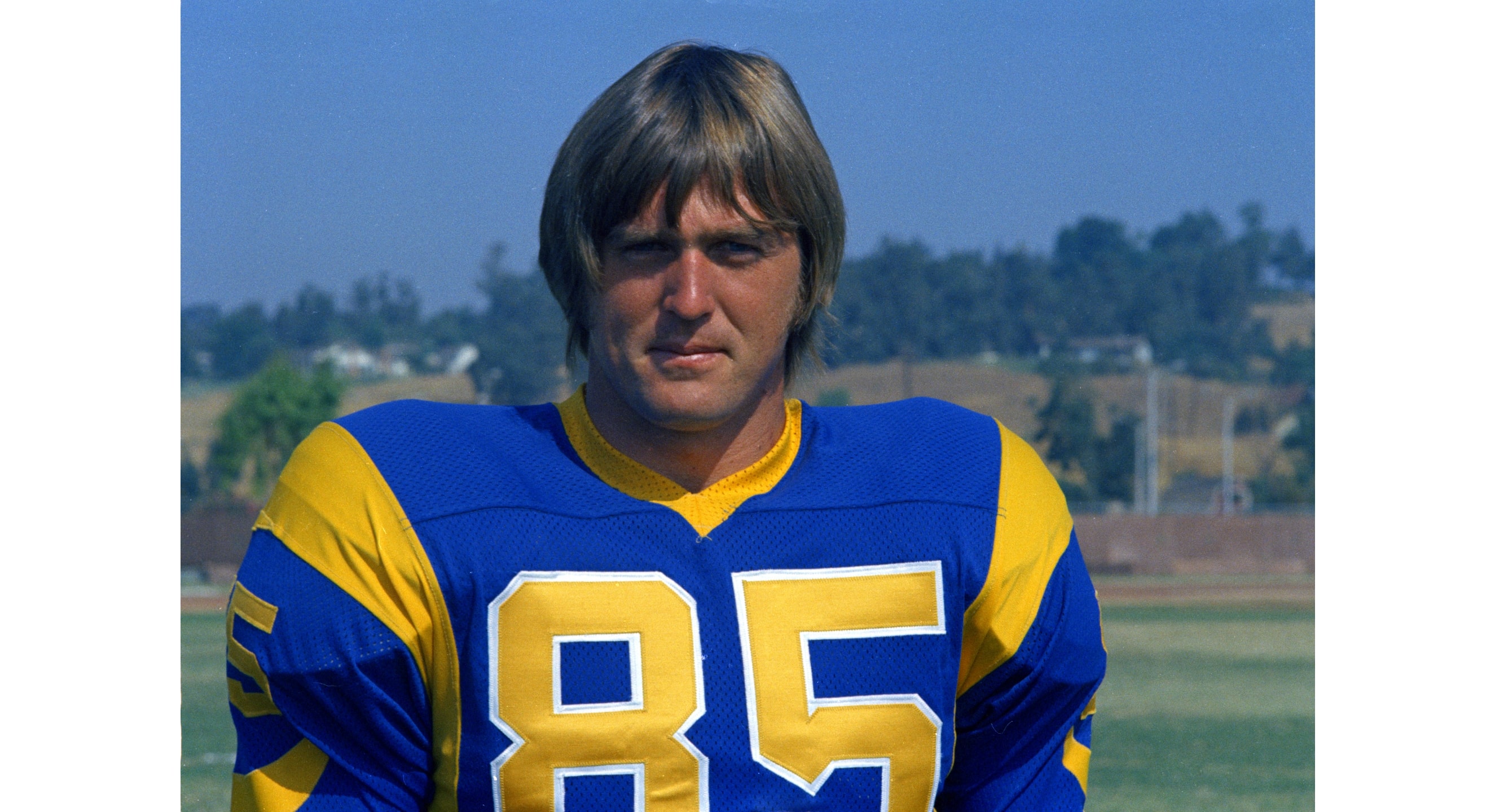
1983 would see the debut of a Ram legend. Running back Eric Dickerson was instantly recognizable by his signature goggles, white neck roll, and Vettex mouth guard. Dickerson would go on to win countless awards, have his jersey retired by the team and be inducted into the Pro Football Hall of Fame.
Making Another Move
The Rams would make yet another move in 1995, this time to St. Louis, Missouri. Their uniforms would remain the same aside from the addition of a new “inaugural season” patch. It was in St. Louis that the team would win their third Super Bowl championship in 1999. This made the Rams the only team in NFL history to win a championship in three different cities.
One year after winning Super Bowl XXXIV, the Rams would have another makeover, switching from blue and yellow to navy and gold. It was in this uniform that the team would face-off with the New England Patriots in the 2002 Super Bowl and ultimately be defeated.
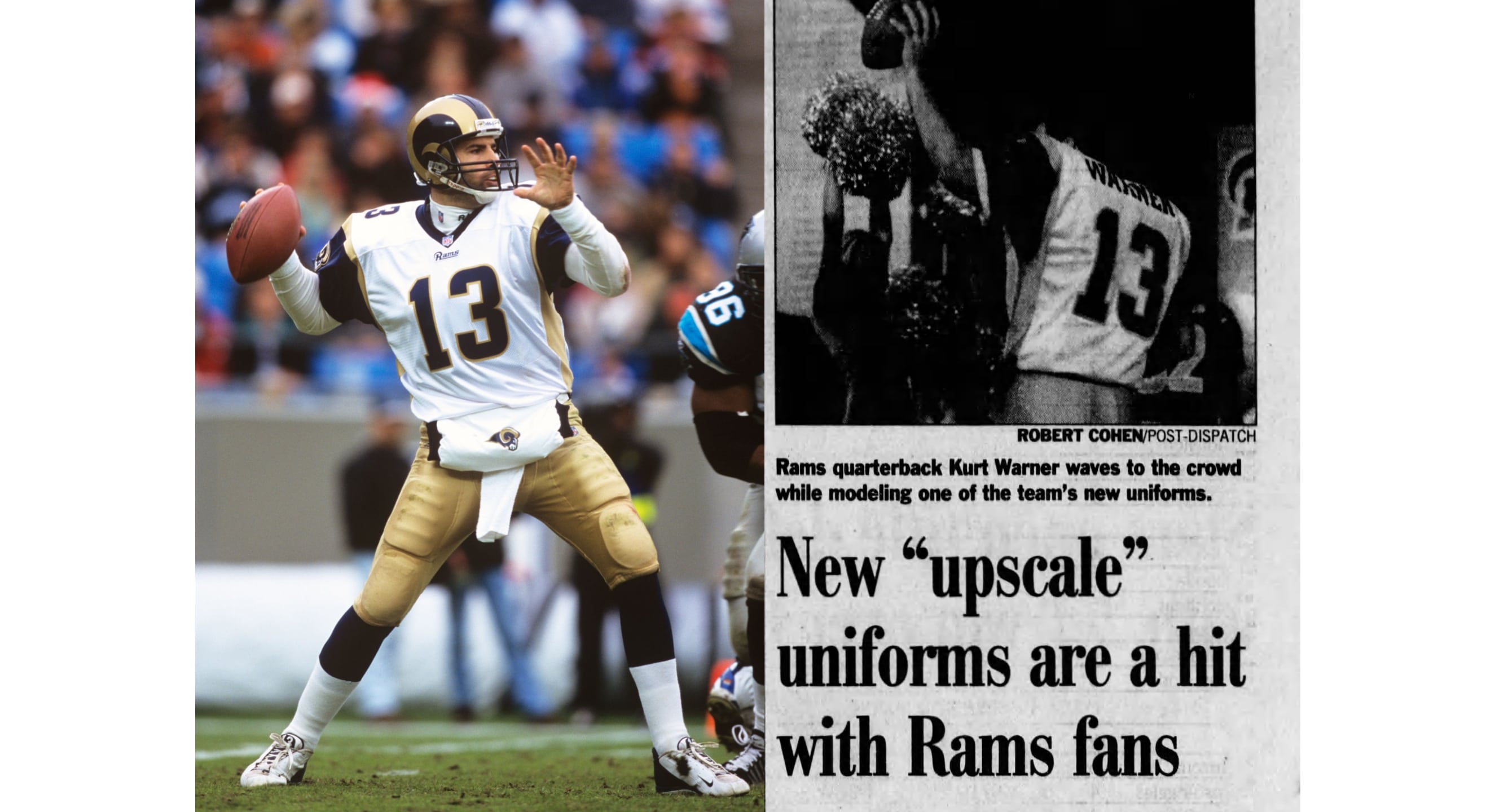
Going Back to Cali
The team made their return to Los Angeles in 2016. A new white horned helmet would be the only major update to the players’ uniforms, other than an updated blue side stripe on white pants. In 2018, The Rams were granted permission to wear their throwback jerseys full-time.
Two years later, the team would make their more recent team color scheme change. A royal blue/sol uniform and a newly designed “LA” logo, fashioned in the shape of horns is what we see on the field today.